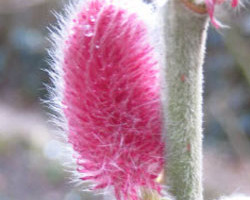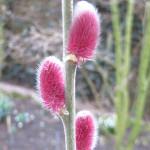
- by Ed
- 0
- Posted on
Flower Fashion: Salix with pink red catkins
Red Catkins for Mother’s Day and Valentine’s Day

SO cute!
SO hot!
But especially women will melt at the sight of those tenderly catkins.
If you see them you just want to touch them.
And guess what!
Now they are also available in marvelous pink red!!!
Pink / red catkins are 100% natural.
They don’t need any dye or artificial colouration during production.
Why red willow catkins are irrisistable for consumers
Red catkins definitely have the X-factor:
- Catkins have the hug-factor .
Their appearance is more silky, fluffy than anything else in floriculture.
If you see them you just want to have a closer look and fondle them. Just like you would caress a snow white rabbit. - Red catkins have the colour of love.
The colour red best represents love and empathy. - They have the cute factor.
Indeed they are tiny, but that’s what makes them so cute. And don’t women love tiny things, like jewelry? It´s the number of catkins that counts. (Size doesn’t always matter.)
Catkins appeals to the senses and therefore perfectly match with todays experience economy.
Why red willow catkins are irrisistable for Horticulture & Floristry
Mother’s Day and Valentine’s Day
Horticulture and floristry can anticipate on Mother’s Day and Valentine’s Day with red catkins. During these ‘Hallmark holidays’ flowers are often bought as an impulse product. Sales during these days generate a higher profit, since everybody wants to shine with a nice bouquet for their loved ones.
Production Planning
Willows are particularly suitable as forcing shrubs for cutting. Naturally, willows produce catkins in early spring (February), just before Valentine’s Day. Since cut willow branches allow for long term storage in cold rooms, their period of use can be extended until Mother’s Day fairly easily.
Easy growing
Tree nurseries may find Salix an interesting crop to grow as a forcing shrub. For the following reasons:
- Salix is easy to propagate by cuttings.
- Salix cultivation doesn’t require fertilization on most soils.
- Salix also thrives on waterlogged soils.
- Salix is resistant to road salt.
- Salix branches generate an additional income in early spring.
Inspiration for using red catkin willows.
Flower Bouquet
Long and slender catkins that protrude above a bouquet always look appealing. Of course the slender and flexible stems offer opportunities for creative bending by florists.
You could combine red catkins with the pastel green flowers of Viburnum opulus ‘Roseum’, which is also an early flowering forcing shrub for cutting.
Heart Shape for garden plants
Salix stems are highly flexible. Bend two willow stems in a heart shape, as is often done with bamboo. You can append this heart shape with almost any garden plant. That way even a dormant garden plant becomes an attractive and appropriate giveaway article for Valentine’s Day and Mother’s Day. The receiver can transplant the plant in their garden and grow their own bunch of flowers during summertime.
When combined with a climbing plant, such as Clematis., the willow also offers support material for climbing. If you want to avoid rooting of the willow, you could give the bottom part of the willow branches a quick dip in molten wax. On the other hand, a sprouted willow could also act as support material for the Clematis. Clematis of pruning group 3, such as Clematis viticella hybrids, and willow can be pruned likewise in the same season and make a great plant combination.
Salix cultivars with red catkins
I did some cultivar research and made a short list of the best red catkin cultivars available for forcing shrub blooms:
- Salix chaenomeloides Mount Asama (Synonym: Mt. Asama)
- Salix chaenomeloides Mount Aso (Synonym: Mt. Aso)
Fluffy willow with red catkins will set the trend for spring 2016.
You can bet red catkins will be trendsetting in springtime next year.
It has taken a few years to propagate red catkin Salix cultivars. This year Salix chaenomeloides Mt. Aso will be available in dribs and drabs. But from 2016 onwards Mt. Aso will be available for florists on a large scale.
Hope this article inspires you to develop a red catkin strategy for next year. I would be happy to think along with you and find a suitable business partner to cooperate with.
Would you appreciate a sparring partner with a piece of premium advice?
Interested to hear news that makes your company flower?
Independent and confidential?
Get in touch with me, and tell me about the passion that drives your business!